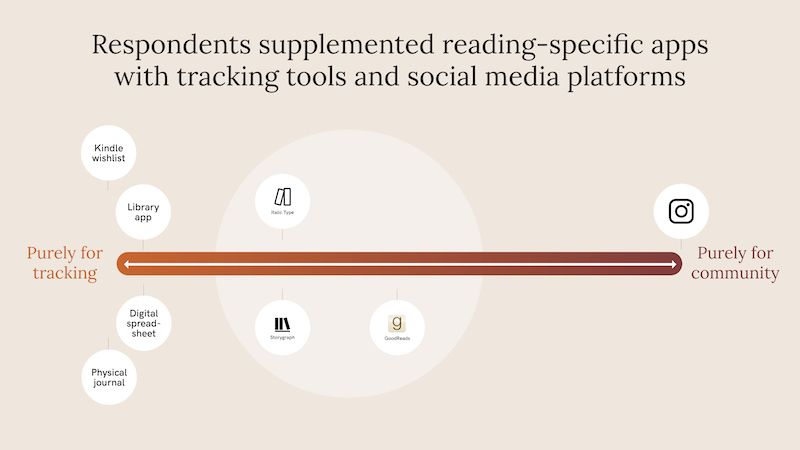How we kept track of books we read in 2022

This post is the fourth in a series of six posts on our findings from our State of the Reader 2022 survey. We conduct this survey every year to shed light on who readers are and what makes them tick.
Nearly all respondents tracked their reading — beyond their own memory! — in 2022.
The vast majority of respondents (91%) tracked their reading in some capacity in 2022 - whether through an official reading app or a more self-driven tool, like a physical notebook or digital spreadsheet.
Respondents near-unanimously (96%) used these apps and custom tools in order to stay organized and record what they wanted to read, were currently reading, and had read. And a healthy share also used them to motivate themselves to read more (46%), find or exchange book recommendations (43%), learn more about their reading patterns (41%), and connect with other readers (40%).
Most used multiple reading apps and tools in combination.
About one-third of the respondents who tracked their reading relied on one single app or tool, but most (64%) used two or more.
Why? When it came to official reading apps, it was because they valued the unique capabilities of each. Let’s dig into the top three — Italic Type (👋!), The StoryGraph, and Goodreads.
Note: We asked directly about four other reading apps - Oku.club, Literal, LibraryThing, and Fable - but none were used by more than 2% of respondents, so we’ve excluded them from this analysis. (In contrast, Italic Type, The StoryGraph, and Goodreads were each used by at least 20% of respondents.)
Italic Type stood out for its beautiful design and its focus on the entire reading experience. Users loved how Book Boards enabled them to record their thoughts as they were in the process of reading - not just after they'd finished! - both on their own and with friends.
The StoryGraph fans appreciated its data and visualizations. They valued its insights into their unique reading behaviors as well as its detailed book-level data, from high-level descriptors (e.g., "mood", character- vs. plot-driven, etc.) to specific content warnings.
Amazon-owned Goodreads continued to dominate on reviews - and on scale. At more than 125 million members, its size was a double-edged sword: while users liked that it was active, they sometimes struggled to find meaningful content amidst the noise.
"Official" reading apps weren't the only ones in play!
Some respondents supplemented reading apps with “pure tracking” tools, such as library request lists, digital spreadsheets, and physical notebooks. They used these “pure tracking” tools to record their TBR and/or Completed lists for their eyes only.

On the other end of the spectrum, respondents also relied on Instagram, aka “Bookstagram”, to broadcast their books and connect over them. (A much smaller share also used TikTok, aka “BookTok,” and YouTube, aka “BookTube.”) While not specifically designed for readers, these social media platforms offered the community they craved.
These respondents explained that while Instagram isn’t a solution for tracking their books, it’s become their go-to for discovering and discussing them; some said that they’ve stopped posting reviews on Goodreads because reviews on Instagram are much likelier to spark conversation. More broadly, they appreciate Bookstagram’s warmth, informality, and interactivity.
“I love Instagram! It's nice to see informal recommendations from friends and acquaintances, in addition to staying up to speed with people who have created book accounts and whose opinions and preferences I value!”
To tie it all together: what’s missing from book tracking?
Respondents had plenty of solutions for tracking their books and organizing their reading life, but when it came to curating their reading community, they had to get creative.
It’s telling that Instagram - and other social media platforms, like TikTok and YouTube - proved so valuable to readers in 2022. Reading-specific apps weren’t meeting readers’ full needs around community and connection.
And that makes us wonder: How do readers want to be in community with one another?
Next: Reading communities. Who did we read with in 2022?
